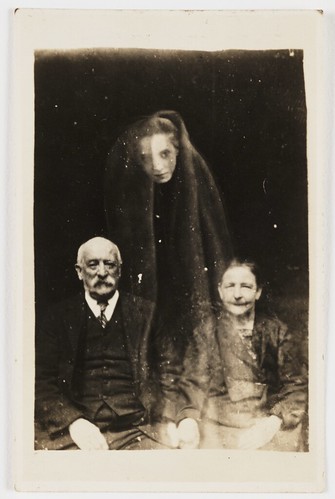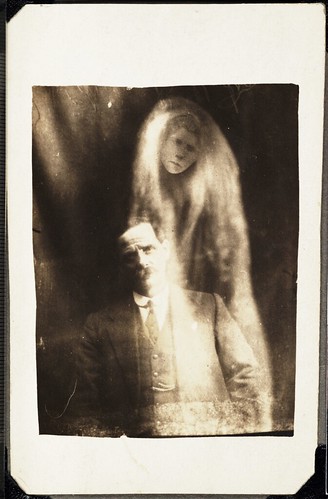One of my favorite ridiculous phenomena of the Victorian Era: the spirit photograph. You could pay money to be photographed and have the supernatural forces around you revealed on a silver plate, be it ectoplasm or be it a mournful feminine face lost a diaphanous swath of otherworldly chiffon.
To the contemporary eye, they’re hilariously, magnificently fake; half-baked tricks of photographic exposure. To me, they’re the perfect combination of anthropology and art, like old sci-fi movies set in a now outdated future. They’re trying to envision something separate from their time and place – death, the year 1995 – but, hampered by their own chintziness, never achieve the escape velocity that real works of speculation or awe do. We are looking at the lowest common denominator for how Victorian-era people (those who could afford a photograph, anyway) conceived of the afterlife.
Their origins are very cynical, these photos, but their falseness has now become quaint and pathetic. Most of these photographers knew that they were scamming customers, but I wonder how many of them were lulled into thought that they were doing a pretty good job at interpreting an actual spirit world. Just helping it along, as it were.
For, example, of this photograph, the National Media Museum makes this note:
“The image of a young man’s face appears prominently over the man, draped in a cloak. The signature at the base of the image belongs to the sitter. The man had links with the person who compiled the spirit album, and he gave the photograph to her as a keepsake. He apparently recognized the young man’s face.”
Did any of these photographers avoid either the pure cynicism of a scammer or the self-delusion of being the spirit world’s darkroom assistant, and instead settle on the middle notion that they were simply giving people comfort?
“A photograph of a mourning scene, probably taken by William Hope (1863-1933) in about 1920. A woman mourns for her husband in a Chapel of Rest, standing by his body which is wrapped in sheets and laden with flowers. The woman’s son stands beside her. The image of a man’s face has been superimposed over the original photograph. The spirit album notes that the family were Roman Catholics and believed in life after death.”
It does make me think about where we we might ourselves, here in this smug moment of the present, be sitting (unbeknown to us) on a little velvet chair, waiting for the nice man to take the exposure and show us another world – above, below, ahead. And about how the effects of sorrow are the same in any time and any place.




